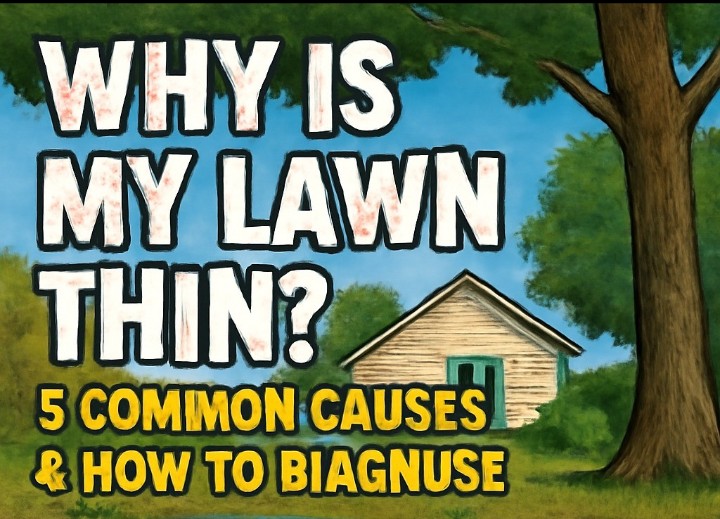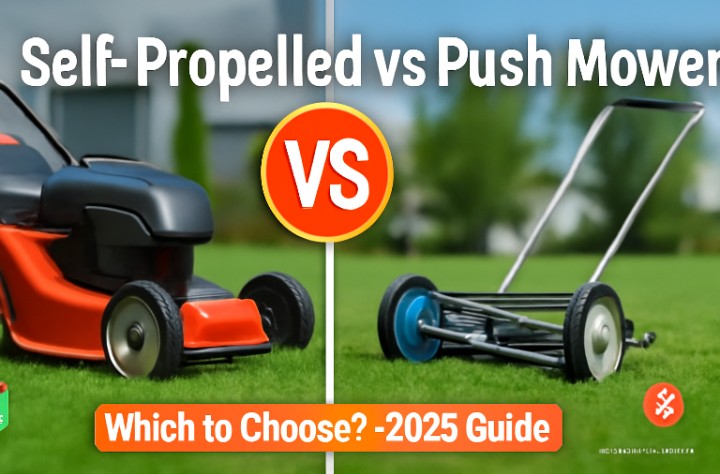A thin, or patchy lawn is not only an eyesore it’s prone to weeds, washes away very easily and reveals deeper problems. Knowing why your lawn is thin is the first step to fixing it. Here are the five worst offenders, and how to tell which is to blame for your grass woes.
1. Soil Compaction (The 1 Cause)
Soil compaction is the number one reason lawns become thin. Compaction occurs when soil particles are pressed closely together, reducing the air pockets that roots and water (as well as other nutrients) require to infiltrate.
What causes it:
- Overtopping of lawns and paths by foot traffic
- Lawn mowers and vehicles driven on grass
- Working on moist soil (most detrimental)
- Heavy clay in the soil where it naturally compacts.
- Construction activity
How to identify compaction:
- Rainwater no longer beads on the surface but rather puddles up instead of soaking in
- Soil feels solid as a rock—it’s tough to push a screwdriver more than 6 inches into soil
- Grass possesses low root depths (2-3 inches)
- Uneven growth with lots of empty patches
- Moss and weeds where grass doesn’t grow
Why it leads to thinning: Compacted soil can smother roots, block water penetration and stifle the ability of your lawn to access nutrients. Even with adequate fertilization and watering, grass cannot flourish in very compacted soil.
2. Environmental Stress
The location and climate where your lawn lives puts stress on it and over time can cause grass to thin.
Drought and inadequate watering:
Because of this, water-stressed grass stops growing new shoots and dies. Symptoms: Blue-gray grass color, footprints visible after walking, and brown patches which enlarge with heat.
Excessive shade:
Grass needs sunlight for photosynthesis. In locations that receive fewer than 4 hours of direct sun, grass is a chlorophyll high wire act because:
- Reduced energy production
- Competition by tree roots for water and nutrients
- Inadequate air flow enhances plant disease
- Longer moisture retention
Grass is naturally a full-sun organism; many whole species can’t live effectively in deep shade.
Heat stress:
Excessively hot summer weather creates dormancy or extremely heavy thinning in cool-season grasses (fescue, bluegrass, ryegrass). Drive ways, walkways and buildings = additional reflected heat.
Poor drainage:
1.Standing water kills the roots in 24-48 hrs. Keep in mind a constantly wet area promotes fungal diseases, which causes roots to remain shallow – and grass is more susceptible to all other stresses when this happens.
3. Soil Health Problems
Nutrient deficiencies:
Your lawn NotesThe recipe:`s To grow thick, your grass requires some specific nutrients:
Nitrogen deficiency (most widespread): Grass is yellow-green, short and has limited stalk formation
Lack of Phosphorus: Inferior root development which plagues emerging grass.
Lack of Potassium: Grass is green and looks healthy but may be flimsy, unable to resist diseases taxonomically.
pH imbalances:
Water content The pH of soil has a very large influence on the availability of nutrients. The ideal range is 6.0-7.0.
Too acid (below 6.0): Nutrients present are unavailable; moss prevails
Too alkaline (above 7.5) Iron is locked up, so the leaves turn yellow; phosphorus isn’t available
Poor soil structure:
Soil low in organic matter – Soil that is low in organic matter does not have good structure, the ability to retain water or helpful organisms. This “dead” soil is incapable of supporting healthy grass growth.
4. Maintenance Mistakes
Whether it’s a sneaky glance or an innocent look, sometimes you are the problem.
Scalping:
Mowing grass too low (shorter than 1/3 of the leaf blade) puts extreme stress on a plant. Scalped grass reveals soil, loses photosynthetic surface and takes several weeks to recover.
Dull mower blades:
Blunt blades rip and tear grass, rather than slicing it neatly. This results in ragged brown tips, additional loss of water and entrances for disease. If the tips of the grass look tattered at 1-2 days after mowing, your blade needs sharpening.
Improper fertilization:
- Over-fertilization in lawn burns grass, and damages the soil microbes
- Under-fertilization causes the grass to be weakened and this will encourage weed growth to take control.
- Incorrect timing results in product losses and may harm grass
Neglected thatch:
A thatch layer thicker than 1/2 inch prevents water, air and nutrients from reaching roots. It’s like walking on a sponge and does not allow overseeding to take hold.
5. Pests and Diseases
Common lawn pests:
Grubs: C-shaped beetle larvae who are white and consume grass roots. Torn-up grass rolls back like carpet — roots are gone
Chinch bugs: Little ones that suck down plant juices, causing environmental yellow things to expand.
Armyworms/sod webworms: Larvae that feed on grass blades, resulting in quick thinning
Fungal diseases:
Brown patch : round dead patches during hot, humid summer and fall.
Dollar spot – little dead spots that become large and thin out areas
Rust: An orange dusty appearance that makes your grass weak
Snow mold: Forms when snow melts, causing matted dead patches
Diagnosing Your Specific Problem
Step 1: Visual inspection
Walk your lawn and note:
- Where are the thin areas? (shade, traffic zones, wet spots?)
- What’s the pattern? (circular, expanding, paths?)
- What is that, besides growing grass? (woods = shade/compaction, weeds = thin grass)
Step 2: Soil test
Experience this for yourself by pressing a screwdriver into soil:
- Easily penetrates at least 6 inches: Okay soil
- Hard to push 3 inches : Compacted Ground
- Very hard, less than 1 to 2 inches: Extremely compacted
Step 3: Root examination
Pull up a little bit of sod and check out some roots:
- Healthy: 4-6 inches deep – white to very light in color, branching
- Issue: 1″-2″ deep, brown/black and scattered
Step 4: Professional soil test
Get a soil test from your county extension office ($10 to $30) or a professional lab. This reveals:
- NPK (and other nutrient values)
- PH (Most relevant for nutrient availability)
- Organic matter content
- Specific recommendations
Don’t guess—test. You might be spreading fertilizer when you really ought to adjust pH or put down phosphorus where your soil already has plenty.
Quick Diagnosis Guide
Shady thinny mossyness going on there – Shadiness stress and maybe compacted
Shallow spots that do not dry out = No slope or flatness to lawn, not fixed by aeration either.
Stiffer soil + uneven growth = Soil compaction
Yellowing Grass Even After Fertilizing = unbalanced pH of the soil or the soil has nutrients lock up
Killing Circular Spots in Summer = Probably fungal disease
Grass comes up easily, no roots with it = Grub Disclaimer: If killed grass has root present, grub not cause of damage
Thin grass under the trees = Competition from roots + shade
Dog-sized dead spots with green rings = Pet urinevertis content Burnt This is a yellowy brown dried out spot.
When to Contact a Medical Professional
Seek expert help if:
- Issues continue after an entire season of proper treatment
- Severe and wide spread damage (disease or extreme pest infestation)
- You are confused by soil testing results
- Topics that are in the large lot over 1 acre range
- Earth moving due to drainage or grading issues
Take Action
Now, however, you know why your lawn is thin and can be more focused in how you respond. As luck would have it, the most frequent culprits — soil compaction and lack of sufficient maintenance — are within your ability to fix.
Immediate next steps:
- Find your main issue with the above diagnosis guide
- Have a soil test done to determine underlying problems (pH, nutrients)
- Priorities: Fix compaction first (because nothing else works without fixing this)
- Learn the Fixes: Read our companion article “How to Thicken Your Lawn: 6 Proven Strategies” for solutions
Remember: The majority of thin lawns are due to more than one contributing factor. Your lawn may have compacted soil AND nutrient deficiencies AND bad mowing. Discuss all the areas one at a time for best results.
Every thick, beautiful lawn you admire began with diagnosis and targeted solutions. Knowing your exact problems is the starting point for breakthrough. Now you’re ready to fix them.






